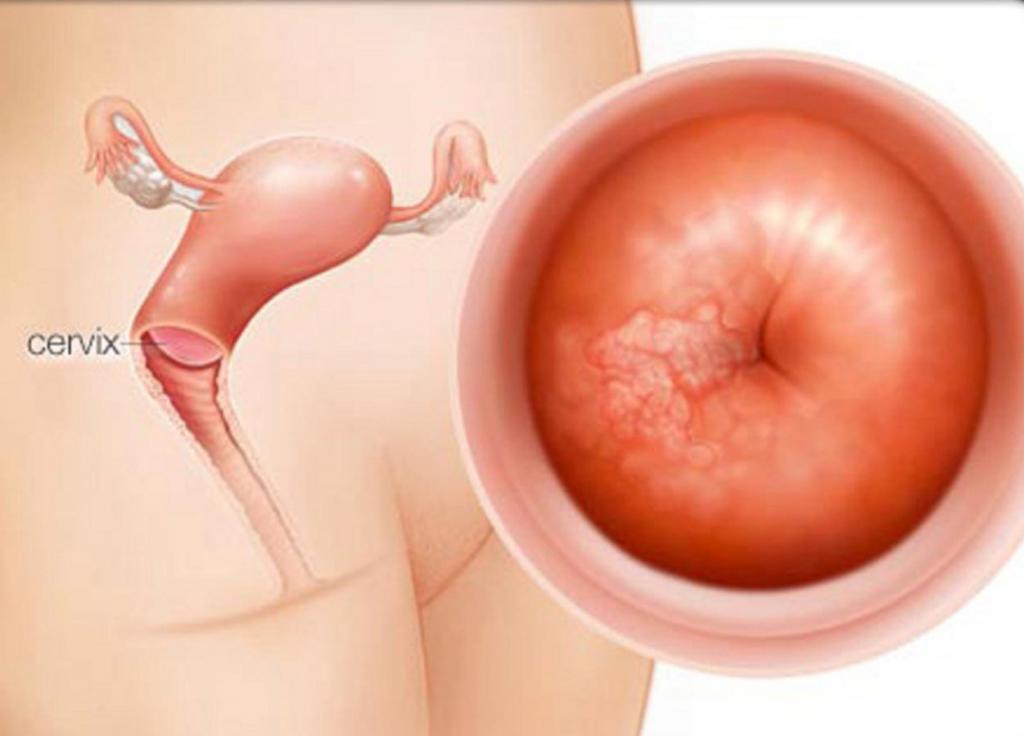Cervical erosion is by far one of the most common gynecological diseases. For many women, this diagnosis becomes news. This pathology is not always accompanied by characteristics characteristic of it, and the presence of other inflammatory or infectious diseases can further blur the clinical picture. In this article, we will examine whether cervical erosion can bleed and what factors provoke its development.
Definition of erosion and its types

Cervical erosion is a peptic ulcer of the cervical mucosa . The long existence of pathology can lead to serious consequences. Since erosion can cause many factors, a certain characteristic is used to indicate the type of its development.
Erosion may be:
- Congenital This type of disease is considered non-hazardous and is a feature of the body. As a rule, it does not require treatment and passes on its own after some time.
- True erosion. This is a mucosal defect that arose as a result of a mechanical injury or against the background of an inflammatory process. Affected tissues are bright red in color and begin to bleed with light contact. After about 2 weeks, such erosion goes into the healing stage.
- Pseudo-erosion (ectopia). This is a condition in which the cylindrical epithelium of the cervical canal is displaced beyond the borders of the external pharynx. It does not have pronounced symptoms. Unusual discharge sometimes occurs and pain during intercourse may bother you.
Reasons for the appearance

There are a large number of factors that can cause erosion. These include:
- Hormonal disruptions.
- The presence of an intrauterine device.
- Abortion
- Mechanical damage to the cervix as a result of a medical examination or during intercourse.
- Allergy to semen.
- Lack of intimate hygiene.
- Inflammatory processes in the pelvic organs.
- Infectious diseases.
Symptomatology
In most cases, the symptoms of erosion are mild. In the early stages of the disease, discomfort during intercourse and minor discharge may occur. If untreated, an inflammatory process can develop, as a result of which the discharge will be more abundant with an unpleasant odor, and sometimes with the presence of blood.
Causes of spotting

There are many factors that cause uterine erosion to bleed:
- Gynecological examination.
- Sexual intercourse.
- With excessive physical exertion.
- With the introduction of tampons.
- Removing or installing an intrauterine device.
- When douching.
- While taking smears.
- An ultrasound examination of the pelvic organs with a vaginal probe.
If bleeding once during erosion, there is no cause for concern. One has only to keep the situation under the control of a doctor. But in cases where the bleeding intensified or arose for no apparent reason, we can talk about the development of a pathological process that requires the intervention of a doctor. A condition in which erosion is bleeding can be caused by exposure to pathogenic microbes, viruses, and infections.
Diagnostics

If there are spotting that is not related to menstruation, you should consult a gynecologist. To confirm the diagnosis and establish the nature of the origin of the disease, the following diagnostic measures are prescribed:
- Gynecological examination.
- Taking a smear.
- Ultrasound of the pelvic organs.
- Screening for STIs and HPV.
- Colposcopy.
- Biopsy.
- Blood and urine tests.
Distinctive features of bleeding during erosion
There are characteristic signs that bleeding is caused precisely by erosion, and not by pathological changes in the pelvic organs and urinary system. Let's consider them in more detail:
- Blood discharge occurs outside of the menstrual cycle.
- The pain is not strong, itching and burning are not observed.
- Allocations are pale brown, scarlet or pink.
- After some time, erosion stops bleeding.
- Almost always, you can find a connection between any mechanical effect on the cervix and spotting.
Many people ask: how long can cervical erosion bleed? A feature of this pathology is that in itself it is not capable of causing prolonged and heavy bleeding, unless dangerous diseases have been added to this. If erosion bleeds for a week or more, this may indicate uterine bleeding or the manifestation of other serious gynecological diseases, which include:
- Endometrial hyperplasia.
- Uterine fibroids.
- Ovarian disease.
- Inflammation of the appendages.
- Oncological formations of the pelvic organs.
- Endometriosis
- Polyps in the uterus.
- Frozen pregnancy.
- Beginning miscarriage.
Uncomplicated cervical erosion bleeds after mechanical stress and does not affect the menstrual cycle and pregnancy.
Treatment

The therapy prescribed by the doctor will depend on the overall clinical picture and test results. Currently, there are several ways to treat erosion. Let's consider them in more detail.
- Drug therapy. This method includes the use of anti-inflammatory drugs, antiviral agents, immunomodulators and drugs that accelerate regeneration. With severe bleeding, hemostatic drugs are prescribed (for example, "Bichromicum").
But, unfortunately, drug therapy in most cases does not cope with erosion, so surgical treatment is prescribed, which can be performed in the following ways:
- Laser moxibustion. This method is the most common, as it is considered one of the most effective and less traumatic treatment options. Affected tissue is removed by a laser beam, while healthy tissue remains intact. If it bleeds after cauterization of erosion, do not worry, as a certain amount of secretions may be present during the period during which the mucosa is restored. But it is important to remember that the appearance of copious discharge, accompanied by itching and pain, as well as yellowish with an unpleasant odor, is an occasion to contact a medical institution as soon as possible.
- Cryodestruction. A safe and effective treatment method in which erosion is frozen with liquid nitrogen. Full recovery takes about two months. This method of treatment is contraindicated in nulliparous women.
- Radio waves. The affected areas of the mucosa are affected by radio waves. Moreover, the probability of bleeding is very low, and the recovery period lasts no more than a month. The method is allowed in nulliparous women.
- Chemical coagulation. A special solution is applied to the damaged tissue, which contributes to the death of the upper layer of cells. The procedure must be repeated several times. When using this method, there is a high risk of damage to healthy cells.
- Electrocoagulation Affected areas of the cervical mucosa are removed using current. The procedure is painful, the risk of scar formation is great.
- With a precancerous condition, a surgical removal of an organ site is performed.
Emergency bleeding
If, for any reason, erosion is very bleeding, it is necessary to call a doctor as soon as possible. Before his arrival, you need to lie down with something under your feet. On the lower abdomen often put cold for 10 minutes, after which take a five-minute break and repeat the procedure.
It is forbidden to take a bath, apply a warm heating pad to the stomach. Taking medications is possible only after consulting a specialist.
Complications

Uncomplicated erosion in most cases does not pose a threat to the life and health of a woman, but if untreated, serious complications can develop:
- Anemia that occurs with prolonged bleeding.
- Joining an infection.
- Bleeding in chronic erosion is sometimes accompanied by the formation of polyps.
- If erosion is bleeding during the bearing of a child, there is a high risk of the presence of infection and the inflammatory process, which have a negative effect on the course of pregnancy.
- Oncology. If erosion has been bleeding for a long time, and appropriate treatment is not carried out, it can degenerate into cervical cancer.
Conclusion

To avoid the serious consequences of the disease, a regular visit to the gynecologist is necessary. Bleeding with erosion in most cases indicates the development of a pathological process that requires immediate treatment, so with the first symptoms of the disease, you should consult a specialist as soon as possible, who will conduct an examination and prescribe the necessary treatment.